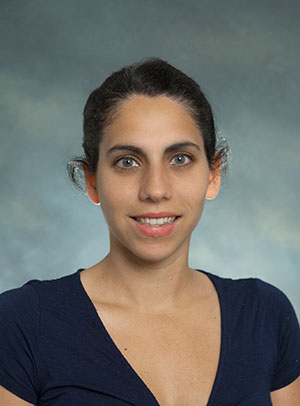The emergence of new technologies has added fascinating new dimensions to MRRI’s research in translational neurorehabilitation. Using virtual reality in the treatment of phantom limb pain, noninvasive brain stimulation to improve stroke patients’ motor deficits, and iPhone apps to track concussion symptoms after a sports injury are some of the ways in which MRRI researchers are using tech in their work. Here’s an overview of the ways in which researchers Laurel Buxbaum, Amanda Rabinowitz, and Shailesh Kantak are using tech to push neurorehabilitation research into the future.
Laurel Buxbaum, Psy.D., MRRI associate director and director of the Cognition and Action Lab, has two projects that use virtual reality to help measure behavioral difficulties and aid recovery. The first uses a system developed by her group at MRRI called the Virtual Reality Lateralized Attention Test (VRLAT) to measure hemispatial neglect in stroke patients. Patients view a winding path that they navigate virtually. They’re asked to identify certain objects along the path. It’s similar to traditional paper and pencil tests of spatial neglect, where patients pick out certain objects in the field—except the VRLAT provides a more accurate measurement of patients’ abilities and deficits.
“We already have validation—a strong correlation with peoples’ collisions in real life,” says Dr. Buxbaum, “and the VRLAT correlates with real-life collisions better than paper-and-pencil tests.” Dr. Buxbaum adds that another benefit of the VRLAT is that it allows clinicians a more accurate measure of how well therapy is working so that they can track progress over time.
Dr. Buxbaum’s other project uses VR to treat phantom limb pain in people who have lower limb amputation. Phantom limb pain is thought to arise from a mismatch between the sensory feedback the brain expects to receive from the missing limb and the feedback it actually receives. Rectifying this mismatch, Buxbaum and her colleagues wagered, might reduce the pain experienced by the patient. So she and her colleagues, Branch Coslett, MD, Katherine Kuchenbecker, Ph.D., and Alex Miller of the University of Pennsylvania developed a VR system where the patient views a virtual world, and can see the legs of his or her own avatar—two complete legs that move when the patient moves. Different tasks and games provide feedback that seems to reduce the amount of neurosensory mismatch that produces the phantom pain.
So far, pilot data have produced promising results and have resulted in NIH funding. Next Buxbaum and her colleagues expect to enroll 25 patients in an upcoming study, and if successful, will submit follow-up grants to NIH and elsewhere for a larger clinical trial.
“We think that there are many exciting new technologies that can be used in the service of aiding rehabilitation,” says Dr. Buxbaum, “both in terms of patients’ engagement in their own treatment, and therefore the amount of time they’re willing to practice, as well as in more accurate assessment and feedback that are useful to patients and therapists.”
 Meanwhile, Amanda Rabinowitz, PhD, Director of MRRI’s Brain Injury Neuropsychology Lab, is working on another problem: how to accurately track concussion symptoms in young sports players who have sustained head injuries. Current assessments of symptoms, balance and cognitive problems tend to fall short for a variety of reasons, including accuracy and user-friendliness. To get a closer look at the moment-to-moment symptoms a person with concussion may experience, she’s taking advantage of a tool that almost everyone carries around with them—a smart phone. Dr. Rabinowitz developed an app that has users rate their levels of various symptoms, generally five times per day.
Meanwhile, Amanda Rabinowitz, PhD, Director of MRRI’s Brain Injury Neuropsychology Lab, is working on another problem: how to accurately track concussion symptoms in young sports players who have sustained head injuries. Current assessments of symptoms, balance and cognitive problems tend to fall short for a variety of reasons, including accuracy and user-friendliness. To get a closer look at the moment-to-moment symptoms a person with concussion may experience, she’s taking advantage of a tool that almost everyone carries around with them—a smart phone. Dr. Rabinowitz developed an app that has users rate their levels of various symptoms, generally five times per day.
“To look at symptoms in the immediate aftermath of concussion,” she says, “we set up patients with a smart phone app that pings them multiple times a day, asking them about common symptoms such as dizziness, nausea, headache, and fatigue.” It also correlates symptoms with one another, since some tend to go hand-in-hand, like dizziness and headache. She says that because concussion symptoms are notoriously broad, tracking them in real time to see how they fluctuate and interact may help clinicians get a better grasp of their nature, and when it’s safe to let someone return to their usual activities.
“We also want to tease apart what symptoms might be elevated from the injury vs. an individual’s predisposition,” says Dr. Rabinowitz. “It can be tough to tease out which symptoms are indicative of brain injury, and which symptoms may be elevated for another reason, like depression or stress.”
Most players recover fairly swiftly from concussion, but about 20 percent of patients find that symptoms linger. Identifying those patients should help them get better treatment. “This method—collecting fine-grained data from individuals as they go about their day—has the promise of linking individual patients to treatments that are most likely to benefit them,” she says. “Gathering this kind of data brings things into focus.”
Dr. Rabinowitz agrees that this is an exciting time in the field. “There are a lot of different tech modalities out there for neurorehabilitation. One constraint has been that it’s hard and costly to deliver services in house—treatments like VR and iPhone apps are cheap and patients can do them at home. With a smartphone app, we can get more precise assessment—people always have their phone with them. We could even deliver treatment for problems like depression and anxiety that are associated with TBI. That’s literally moving treatment to a person’s pocket.”
Shailesh Kantak PhD, PT, Director of MRRI’s Neuroplasticity and Motor Behavior Laboratory, is looking at the ways in which different technologies can help stroke patients, both by measuring neurological damage and helping patients regain function. In one of his projects, Dr. Kantak is using virtual reality to tweak a stroke patient’s perception of his or her own movement. Using a VR environment, a patient is asked to do various tasks that involve both arms, and visual feedback about how the affected body part is moving (that is, their “avatar’s” body part) may be shifted, depending on the patient’s needs.
“Using VR, the movement of the weaker hand can be augmented or reduced,” says Dr. Kantak. “If I’m moving a virtual tray, for example, my left hand may be lagging behind. The feedback can be manipulated, so that now I am forced to actually change, very implicitly, this mapping of what I’m doing and the feedback I’m getting.” It’s a form of learning that’s well below the level of conscious thought, but is proving to be an effective way of helping stoke patients regain function of the affected side.
Dr. Kantak is also looking at ways in which noninvasive brain stimulation—like transcranial magnetic stimulation (TMS)—may be used to affect neural function in specific areas of the brain. “In patients with neurological disorders, neural connections aren’t working optimally,” he says. “One promising treatment approach stimulates the neurons that aren’t functioning well. We identify those areas, then use methods like TMS to augment or reduce the excitability of neurons. This has very specific effects on motor movement and behavior.”
Dr. Kantak’s lab is also finishing up a study in which patients were taught a complex motor task, and activity in their primary motor cortices was measured as they learned. “We quantify changes in activity in the primary motor cortex when people learn a task,” says Dr. Kantak. “Some people show greater connectivity after learning, but mostly we see changes in the excitability of the neurons. There’s a lot of variability between people, and we want to understand these inter-individual effects.” Knowing how individual responses vary will help tailor treatments based on an individual’s likely response to them.
Like his colleagues, Dr. Kantak is excited about how technology has enhanced the field, and will continue to do so, bringing more refined, cheaper, and more portable treatment methods to patients who need them.
“MossRehab and MRRI are spearheading the integration of technology into neurorehabilitation, not only in research, but also in the clinic”, he says. “What makes us unique is that we don’t just take tech and put it in the clinic—it’s a staged approach. We use technology to understand mechanisms, such as which patients will benefit and why. That scientific approach is going to be really important for future clinical trials, and for eventual implementation into everyday clinical practice.”




2 comment on “MRRI advances neurorehabilitation with innovative technologies”